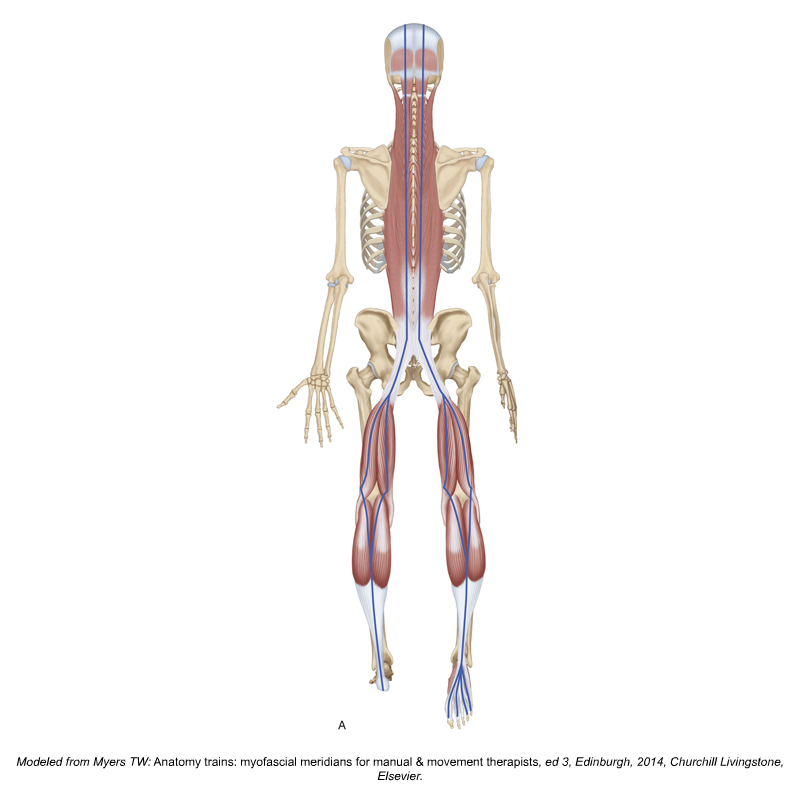Remote Stretching

Superficial Back Line Myofascial Meridian. Permission Joseph E. Muscolino. Kinesiology – The Skeletal System and Muscle Function, 3rd Edition (Elsevier, 2017). Modeled from a drawing by Tom Myers, Anatomy Trains.
Recent research has confirmed that remote stretching (also known as non-local stretching) has effects in distant parts of the body. For example, self-myofascial release using foam roller massage of the plantar fascia (in effect stretching) can increase hamstring extensibility.
A possible mechanism to explain the effects of remote stretching consists of mechanical force transmission of tension forces across myofascial meridians (myofascial chains / anatomy trains). However, some sources believe that the degree of structural continuity in these meridians/chains decreases with age, which, if true, would mean that the magnitude of the remote effects might also be reduced throughout the lifespan. For this reason, a study was done that examined whether age influenced the effects of remote stretching.
Study
A study from Goethe University in Germany examined the effect of remote stretching via self-massage release on the plantar fascia upon hamstring flexibility. Further, a major focus of the study was to examine whether age has an influence upon the effects of remote stretching.
The study recruited 168 healthy participants (45 ± 21 years; 85 males and 83 females). The participants conducted one 120-second bout of plantar foot self-myofascial release, performed in standing position. Following the treatment, hamstring extensibility was assessed using sit and reach testing. Relative pre/post differences were measured and classified into three categories: no improvement, clinically non-relevant improvement, or clinically relevant improvement.
Digital COMT
Did you know that Digital COMT (Digital Clinical Orthopedic Manual Therapy), Dr. Joe Muscolino’s continuing education video streaming subscription service for massage therapists (and all manual therapists and movement professionals), has at present (September of 2018) more than 1,000 video lessons on manual therapy continuing education, including entire folders on massage therapy, stretching, and joint mobilization. And we add seven (7) new videos lessons each and every week! And nothing ever goes away. There are also folders on Pathomechanics and Anatomy and Physiology, including an entire folder on Cadaver Anatomy… and many, many more on other manual and movement therapy assessment and treatment techniques? Click here for more information.
Results
The results showed that self-myofascial release of the plantar fascia (in other words, remote stretching) increased hamstring extensibility by 10.1% (pre: 24.9 ± 9.7 cm, post: 27.4 ± 9.3 cm). Quite striking was that ninety-nine (99) of the 168 participants (58.9 %) attained a clinically relevant change.
Data analysis demonstrated no influence of gender, amount of physical activity, height, BMI, and time of day.
However, the analysis did confirm that age, corrected for baseline flexibility, did have a small to moderate association with treatment effectivity, with increasing age correlating with a decreased effect of remote stretching.
Role of the Central Nervous System
Another possible mechanism that might underlie the effectiveness of remote stretching is the involvement of the central nervous system. After all, the flexibility of musculature is largely dependent upon “muscle memory” tone, which is determined by the central nervous system’s control (specifically the gamma motor system’s control) of muscle spindle activity. Certainly, it is possible that both physical mechanical effects (myofascial meridians) and neural mechanical effects (muscle memory) are in play.
This blog post article was created in collaboration with www.terrarosa.com.au.
Digital COMT
Did you know that Digital COMT (Digital Clinical Orthopedic Manual Therapy), Dr. Joe Muscolino’s continuing education video streaming subscription service for massage therapists (and all manual therapists and movement professionals), has at present (September of 2018) more than 1,000 video lessons on manual therapy continuing education, including entire folders on massage therapy, stretching, and joint mobilization. And we add seven (7) new videos lessons each and every week! And nothing ever goes away. There are also folders on Pathomechanics and Anatomy and Physiology, including an entire folder on Cadaver Anatomy… and many, many more on other manual and movement therapy assessment and treatment techniques? Click here for more information.

